17.4 Alcohols from Carbonyl Compounds: Reduction
The most general method for preparing alcohols, both in the laboratory and in living organisms, is by reduction of a carbonyl compound. Just as reduction of an alkene adds hydrogen to a C=C bond to give an alkane (Section 8.6), reduction of a carbonyl compound adds hydrogen to a C=O bond to give an alcohol. All kinds of carbonyl compounds can be reduced, including aldehydes, ketones, carboxylic acids, and esters.

Reduction of Aldehydes and Ketones
Aldehydes are easily reduced to give primary alcohols, and ketones are reduced to give secondary alcohols.

Dozens of reagents are used in the laboratory to reduce aldehydes and ketones, depending on the circumstances, but sodium borohydride, NaBH4, is usually chosen because of its safety and ease of handling. Sodium borohydride is a white, crystalline solid that can be weighed in the open atmosphere and used in either water or alcohol solution.
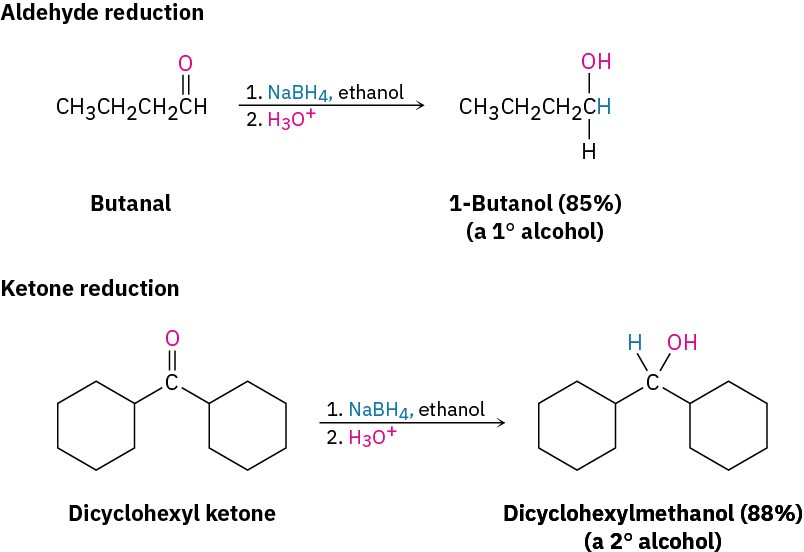
Lithium aluminum hydride, LiAlH4, is another reducing agent often used for reduction of aldehydes and ketones. A grayish powder that is soluble in ether and tetrahydrofuran,
LiAlH4 is much more reactive than NaBH4 but also much more dangerous. It reacts violently with water and decomposes explosively when heated above 120 °C.
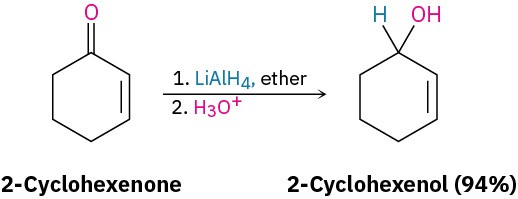
We’ll defer a detailed discussion of these reductions until Chapter 19. For the moment, we’ll simply note that they involve the addition of a nucleophilic hydride ion (:H–) to the positively polarized, electrophilic carbon atom of the carbonyl group. The initial product is an alkoxide ion, which is protonated by addition of H3O+ in a second step to yield the alcohol product.
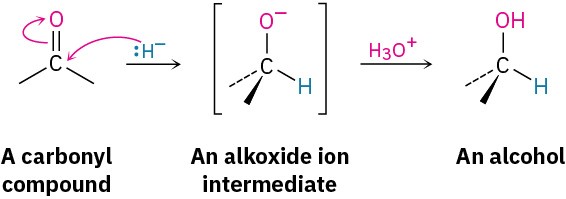
In living organisms, aldehyde and ketone reductions are carried out by either of the coenzymes NADH (reduced nicotinamide adenine dinucleotide) or NADPH (reduced nicotinamide adenine dinucleotide phosphate). Although these biological “reagents” are much more complex structurally than NaBH4 or LiAlH4, the mechanisms of laboratory and biological reactions are similar. The coenzyme acts as a hydride-ion donor to give an alkoxide anion, and the intermediate anion is then protonated by acid. An example is the reduction of acetoacetyl ACP to β-hydroxybutyryl ACP, a step in the biological synthesis of fats (Figure 17.5). Note that the pro-R hydrogen of NADPH is the one transferred in this example. Enzyme-catalyzed reactions usually occur with high specificity, although it’s not usually possible to predict the stereochemical result before the fact.
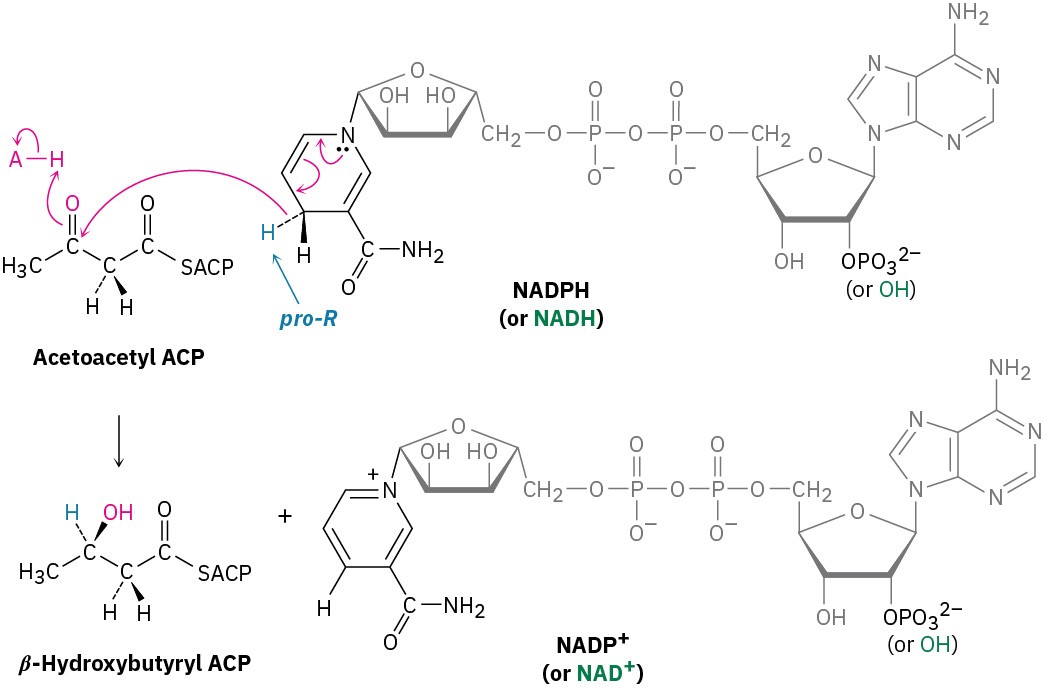
Figure 17.5 The biological reduction of a ketone (acetoacetyl ACP) to an alcohol (β– hydroxybutyryl ACP) by NADPH.
Reduction of Carboxylic Acids and Esters
Carboxylic acids and esters are reduced to give primary alcohols.

These reactions aren’t as rapid as the reductions of aldehydes and ketones. NaBH4 reduces esters very slowly and does not reduce carboxylic acids at all. Instead, carboxylic acid and ester reductions are usually carried out with the more reactive reducing agent LiAlH4. All carbonyl groups, including acids, esters, ketones, and aldehydes, are reduced by LiAlH4.
Note that one hydrogen atom is delivered to the carbonyl carbon atom during aldehyde and ketone reductions but that two hydrogens become bonded to the former carbonyl carbon during carboxylic acid and ester reductions. We’ll defer a discussion of the mechanisms of these reactions until Chapter 21.
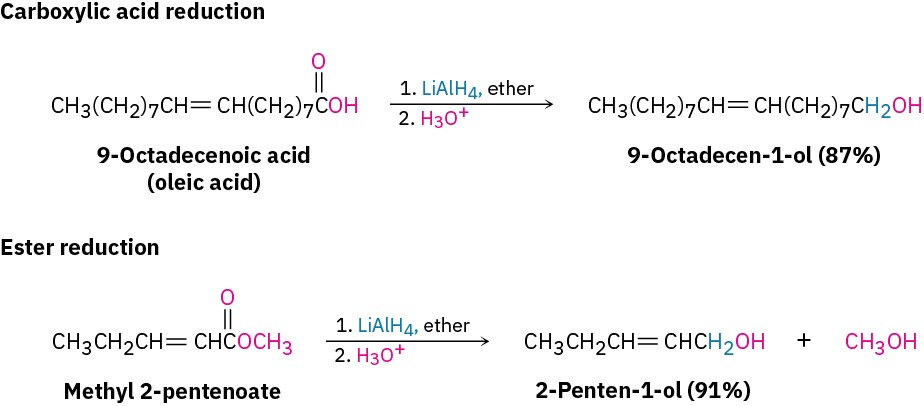
Worked Example 17.2Identifying a Reactant, Given the ProductWhat carbonyl compounds would you reduce to obtain the following alcohols?
 StrategyIdentify the target alcohol as primary, secondary, or tertiary. A primary alcohol can be prepared by reduction of an aldehyde, an ester, or a carboxylic acid; a secondary alcohol can be prepared by reduction of a ketone; and a tertiary alcohol can’t be prepared by reduction.Solution(a) The target molecule is a secondary alcohol, which can be prepared only by reduction of a ketone. Either NaBH4 or LiAlH4 can be used.
StrategyIdentify the target alcohol as primary, secondary, or tertiary. A primary alcohol can be prepared by reduction of an aldehyde, an ester, or a carboxylic acid; a secondary alcohol can be prepared by reduction of a ketone; and a tertiary alcohol can’t be prepared by reduction.Solution(a) The target molecule is a secondary alcohol, which can be prepared only by reduction of a ketone. Either NaBH4 or LiAlH4 can be used.
 (b) The target molecule is a primary alcohol, which can be prepared by reduction of an aldehyde, an ester, or a carboxylic acid. LiAlH4 is needed for the ester and carboxylic acid reductions.
(b) The target molecule is a primary alcohol, which can be prepared by reduction of an aldehyde, an ester, or a carboxylic acid. LiAlH4 is needed for the ester and carboxylic acid reductions.
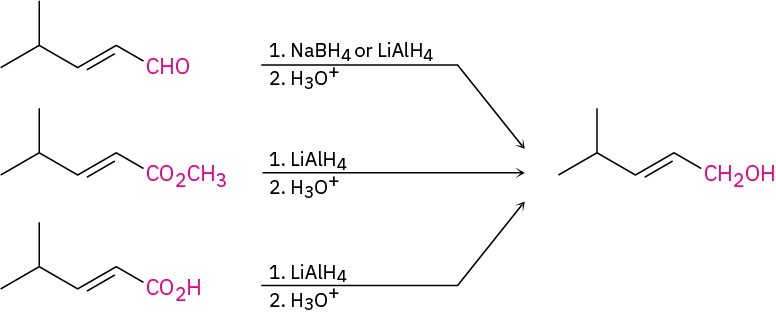
Problem 17-7
What reagent would you use to accomplish each of the following reactions? (a)

(b)

(c)
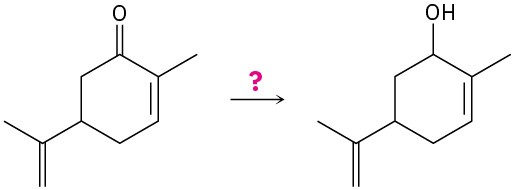
Problem 17-8
What carbonyl compounds give the following alcohols on reduction with LiAlH4? Show all possibilities.
(a)
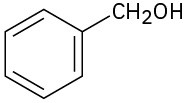
(b)
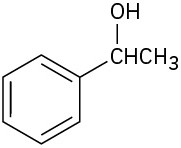
(c)
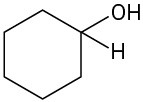
(d)


